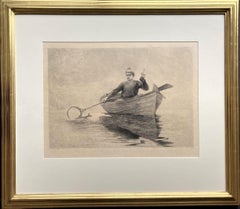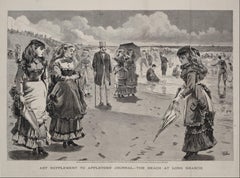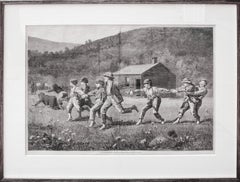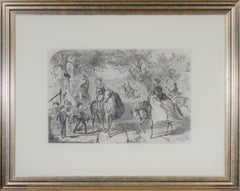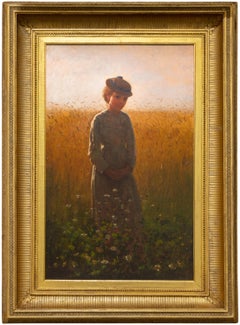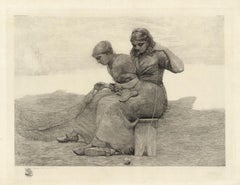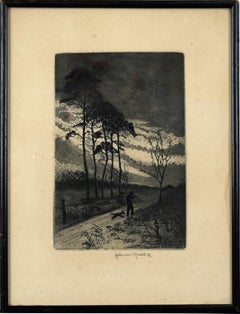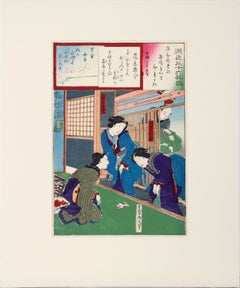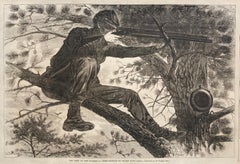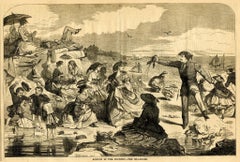Winslow Homer Art
American, 1836-1910
Winslow Homer (1836-1910) was an American landscape painter, printmaker and publication illustrator. He is considered one of the most important American artists of the 19th-century. Largely self-taught Homer initially worked as an illustrator for various publications, including: Harper's Weekly, Frank Leslie's Illustrated Newspaper and Ballou's Pictorial Magazine. He worked for Harper's during the Civil War, producing woodcut engravings depicting the personal experiences of soldiers. He later became a master of oil and watercolor painting, often focussing on maritime themes.
Harper’s Weekly, published in New York, was an extremely popular publication in the nineteenth and early twentieth centuries. In weekly issues Harper’s reported the news, entertained with literature, poetry and art, as well as educating its readers about world affairs and new inventions. It's woodcut engraved illustrations and literature added to its popularity, employing major artists and authors of the time, including Winslow Homer, Charles Dickens, William Makepeace Thackeray and Thomas Nast. to
1
1
3
1
2
Overall Width
to
Overall Height
to
7
2
1
5
2
5
3
2
2
2
2
1
1
1
1
1
3
2
2
1
1
7
8,816
2,808
1,655
1,313
4
7
Artist: Winslow Homer
Fly Fishing, Saranac Lake
By Winslow Homer
Located in Storrs, CT
Fly Fishing, Saranac Lake. 1889. Etching, aquatint and burnishing. Goodrich 104. 14 1/4 x 20 5/8; sheet 18 1/2 x 24 1/2. Edition unknown but quite possibl...
Category
Late 19th Century American Modern Winslow Homer Art
Materials
Etching
$40,000 Sale Price
20% Off
The Beach at Long Branch
By Winslow Homer
Located in Fairlawn, OH
The Beach at Long Branch
Woodengraving, 1869
Signed in the block lower right "WH" ( see photo )
Published in Appleton’s Journal of Literature, Science and Art, August 21, 1869
Condit...
Category
1860s American Realist Winslow Homer Art
Materials
Engraving
Winslow Homer "Snap The Whip" Harper's illustration, engraved by Lagarde
By Winslow Homer
Located in New York, NY
Winslow Homer
Snap The Whip, 1873
Engraving
Sight: 14 1/4 x 20 in.
Framed: 20 x 26 3/4 x 1 1/4 in.
Inscription: in block: "Homer 1873, Lagarde Sc."
printed below image: "Snap-the-Whi...
Category
1870s American Impressionist Winslow Homer Art
Materials
Engraving
19th century woodcut engraving print figurative American forest trees scene
By Winslow Homer
Located in Milwaukee, WI
The present woodcut engraving is an original print designed by Winslow Homer, originally published in Harper's Weekly on April 30, 1859. It is an excellent example of the many prints Homer produced of fashionable people engaged in leisurely activities, in this case along a picturesque countryside lane. The sign reading 'Belmont' on the left indicates this is probably near his home in Belmont Massachusetts. The image presents multiple figures, both men and women, riding horseback: Some in the distance gallop away, toward a town marked by a church steeple beyond. Three others in the foreground, including two equestrian women, gather around a group of children who have been gathering flowers and trapping birds...
Category
1850s Victorian Winslow Homer Art
Materials
Woodcut, Engraving
In the Wheatfield (Girl Standing in a Wheat Field)
By Winslow Homer
Located in Palm Desert, CA
"In the Wheatfield (Girl Standing in a Wheat Field)" is a painting by Winslow Homer. The painting is signed, lower left, "Homer 1873". The framed piece measures 29 3/4 x 21 5/8 x 2 7/8 in.
During the early 1870s, Winslow Homer frequently painted scenes of country living near a small farm hamlet renowned for generations for its remarkable stands of wheat, situated between the Hudson River and the Catskills in New York state. Today Hurley is far more famous for inspiring one of Homer’s greatest works, Snap the Whip...
Category
1870s Realist Winslow Homer Art
Materials
Canvas, Oil
Mending the Tears
By Winslow Homer
Located in New York, NY
Winslow Homer created this etching entitled “MENDING THE TEARS” in 1888. This is a lifetime impression signed by Homer and printed by the famous New York etcher George W. H. Ritchie.
This piece is signed in pencil “Winslow Homer, N.A.” in the lower left above the etched remarque of an anchor. Etched above the image (top left) is “Copyright, 1888 by Winslow Homer N.Y.” and (top right) “G. W. H. Ritchie Imp.” Also etched in the plate (lower right) “Winslow Homer Sc.” ). The printed image size 15.25 x 21.5" (38.8 x 54.5 cm) plus margins – printed on Japan paper. This item is in very good condition and framed in 2.25 inch scooped molding finished in gold leaf with a rag stock bevel (mat edge) wrapped in metal leaf and rag stock top mat wrapped in silk. Glazed in TruVue Museum Glass.
“Winslow Homer (1836-1910) was one of America's great artists of the 19th century and the sea...
Category
1880s American Impressionist Winslow Homer Art
Materials
Etching
The Bathers
By Winslow Homer
Located in Fairlawn, OH
The Bathers
Woodengraving, 1873
As published in Harper's Weekly, August 2, 1873 (p. 668)
Provenance:
Wunderlich & Co., Inc., New York, NY (Their stock no. 84.003.8 in pencil recto a...
Category
1870s American Realist Winslow Homer Art
Materials
Woodcut
Related Items
"End of Day" Original Limited Edition Etching
Located in Soquel, CA
"End of Day" Original Limited Edition Etching by John McGrath (Irish/American b.1884 d.1942).
This etching depicts a man with a tool slung over his shoulder walking along a path th...
Category
Early 20th Century American Realist Winslow Homer Art
Materials
Paper, Ink, Drypoint, Etching
$600 Sale Price
25% Off
H 12.5 in W 9.5 in D 0.5 in
"Enshoku Sanju-roku Kasen" (Thirty-six Enchanting Flowers) Woodblock on paper
By Toyohara Kunichika
Located in Soquel, CA
"Enshoku Sanju-roku Kasen" (Thirty-six Enchanting Flowers) Woodblock on paper
Elegant woodblock print by Toyohara Kunuchika (Japanese, 1835-1900). Three women are in talking with each other inside, while a man waits outside holding a bag of some kind. The colors in this piece are rich and saturated, primarily blues, greens, and purple.
Mat size: 16"H x 20"W
Paper size: 14.75"H x 9.88"W
Born in 1835, Toyohara Kunichika grew up in the Kyobashi district of Edo in the midst of merchants and artisans. In 1848, at age 13, he was accepted as an apprentice into the studio of Utagawa Kunisada I...
Category
1880s Edo Winslow Homer Art
Materials
Ink, Rice Paper, Woodcut
$475
H 20 in W 16 in D 0.25 in
PHOEBE PASSES MY GATE
Located in Portland, ME
Hutty, Alfred. PHOEBE PASSES MY GATE.
Drypoint, c. 1931. Edition size c.75.
8 1/8 x 7 1/4 inches (plate), 10 1/4 x 8 3/4 inches (sheet).
Print...
Category
1930s American Realist Winslow Homer Art
Materials
Drypoint
TRIPLE SELF-PORTRAIT
By Norman Rockwell
Located in Aventura, FL
Collotype in colors on paper. Unsigned. Published in 1972. Copyright info in typeset lower margin.
Artwork is in excellent condition. All reasonable offers will be considered.
Category
1970s American Impressionist Winslow Homer Art
Materials
Paper, Lithograph
English 20th century portrait of an English Frigate in full sail at sea in oils.
Located in Woodbury, CT
English 20th century portrait of an English Frigate in full sail at sea in oils.
A very well painted oil on canvas with great detail of a ship cutting through the sea at I'm sure great speed.
The piece is an oil on canvas with I think gouache added to the waves to make them a brighter white.
The piece is signed Mason and with some investigation, we are attributing this painting to the talented English painter Barry Mason...
Category
1980s Realist Winslow Homer Art
Materials
Canvas, Oil
$2,360 Sale Price
20% Off
H 22 in W 30 in
"Local Residents, " Oil painting
By Judd Mercer
Located in Denver, CO
Judd Mercer's (US based) "Local Residents," is an original, handmade oil painting that depicts a green grassy pasture where a herd of black cows graze.
About the Artist:
Judd Mercer is a watercolor painter based in Denver, Colorado. After attending art school for industrial design, Judd pursued a career in digital design and user experience and is co-owner of Elevated Third, a Denver-based digital agency.
After committing to writing and illustrating a full-length fantasy novel in his spare time, Judd began watercolor painting around 2014, studying with teachers such as Alvaro Castagnet, Joseph Zbukvic and Herman Pekel...
Category
2010s Realist Winslow Homer Art
Materials
Oil, Canvas
"First Horse Day, 1896" - Chiyoda Palace - Japanese Woodblock by Chikanobu Yoshu
By Toyohara Chikanobu
Located in Soquel, CA
"First Horse Day, 1896" - Chiyoda Palace - Japanese Woodblock by Chikanobu Yoshu
Colorful and expressive court scne by Toyohara Chikanobu,"Yoshu" (Japanese, 1838-1912).
This is the r...
Category
1890s French School Winslow Homer Art
Materials
Ink, Rice Paper, Woodcut
$875
H 15 in W 10.5 in D 0.5 in
Bowling on the Green (from the Bicentennial Pageant of George Washington)
By Childe Hassam
Located in Soquel, CA
Bowling on the Green (from the Bicentennial Pageant of George Washington)
'Bowling on the Green', by printmaker Frederick Childe Hassam, depicts George Washington and friends lawn b...
Category
1930s American Impressionist Winslow Homer Art
Materials
Ink, Etching, Laid Paper
$1,680
H 16 in W 20 in D 0.25 in
Santa Fe The Chief Way original American railroad poster
Located in Spokane, WA
Original Santa Fe The Chief Way vintage railroad travel poster. Archival linen backed in very fine condition, ready to frame. Most of the Santa Fe Railway posters feature American Indians, but this poster features the big boss, The Chief! The poster has about a 1" white border around the entire image, the linen backing is not counted in the poster's measurement.
Several of the trains were named "Chief" which includes the San Francisco Chief, Texan Chief, Kansas City Chief...
Category
1940s American Impressionist Winslow Homer Art
Materials
Offset
'The Connectors' — Vintage American Realism, New York City
By James Allen
Located in Myrtle Beach, SC
James Allen, 'The Connectors', 1934, etching, edition not stated, Ryan 66. Signed in pencil. A superb, richly-inked impression, on handmade, cream laid paper, with margins (1/2 to 1...
Category
1930s American Realist Winslow Homer Art
Materials
Etching
$5,200
H 12.88 in W 9.82 in
Winter Tracery (Milford Connecticut)
Located in San Francisco, CA
This artwork titled 'Winter Tracery (Milford Connecticut)" is an original drypoint etching by noted American artist Philip Kappel, 1901-1981. It is hand signed and titled in pencil by the artist. The plate mark (Image) size is 9 x 12 inches, framed size is 17.25 x 21.25 inches. Custom framed in a wooden light grey frame, with light grey matting and black color fillet. It is in excellent condition.
About the artist:
Philip Kappel — painter, illustrator, printer, writer, and lecturer — was born on February 10, 1901 in Hartford, CT and died in 1981. Kappel is best remembered for his landscapes, portraits, figures, marine, lithography, and etching. He held a teaching position with H. B. Snell, Boothbay, ME Studios, 1923 and 1924. His addresses in 1929 were 500 Fifth Avenue in New York City and, for the summer, care of Philip Little, 10 Chestnut Street, Salem, MA; and in 1935, Sarasota, FL.
Kappel was a pupil of the Pratt Institute Art School in Brooklyn, NY and Philip Little (1857-1942) and held memberships with the North Shore Artists Association in Gloucester, MA; the Marblehead...
Category
Mid-20th Century American Realist Winslow Homer Art
Materials
Drypoint, Etching
"Skating on Ladies' Pond Central Park": Winslow Homer 19th C. Woodcut Engraving
By Winslow Homer
Located in Alamo, CA
This Winslow Homer woodcut engraving entitled "Skating on the Ladies' Skating-Pond in Central Park, New York", was published in Harper's Weekly in the January 28, 1860 edition. It depicts a large number of men, women and children skating on a recently opened pond in Central Park. At the time of publication of this engraving, Central Park was in the early stages of construction. This engraving documents the very early appearance of Frederick Law Olmstead and Calvert Vaux's masterpiece of landscape design. According to Olmsted, the park was "of great importance as the first real Park made in this century – a democratic development of the highest significance". The people of New York were very proud of the plans for their park. It was stated at the time: "Our Park, which is progressing very satisfactorily under the management of the Commissioners, will undoubtedly be, one of these days, one of the finest place of the kind in the world...Those who saw the Park before the engineers went to work on it are amazed at the beautiful sites which have been contrived with such unpromising materials; all fair persons believe that the enterprise is managed with honesty and good taste."
Skating was rapidly rising in national popularity in part due to the opening of Central Park’s lake to skaters on a Sunday in December 1858 with 300 participants. The following Sunday it attracted ten thousand skaters. By Christmas Day, a reported 50,000 people came to the park, most of them to skate. There were rules governing who could use the skating pond. “The Ladies’ Pond...
Category
1870s American Impressionist Winslow Homer Art
Materials
Engraving, Woodcut
$1,175
H 23.13 in W 29.5 in D 1.13 in
Previously Available Items
A SHARP-SHOOTER - The Army of the Potomoc - On Picket Duty
By Winslow Homer
Located in Santa Monica, CA
(after) WINSLOW HOMER (1836 -1910)
The Army of the Potomoc - A SHARP-SHOOTER – On Picket Duty, 1862 (Beam 99)
Wood engraving as published in Harper’s Weekly November 15, 1862. Ima...
Category
1860s American Realist Winslow Homer Art
Materials
Woodcut
August in the Country-The Seashore
By Winslow Homer
Located in Fairlawn, OH
August in the Country-The Seashore
Wood engraving, 1859
Signed in the block (see photo)
Published in Harper's Weekly, August 27, 1859
Condition: Usual vintage condition with folds, c...
Category
1850s Hudson River School Winslow Homer Art
Materials
Woodcut
Deer Stalking in the Adirondacks in Winter
By Winslow Homer
Located in Fairlawn, OH
Deer Stalking in the Adirondacks in Winter
Wood engraving, 1871
Signed in the block (see photo)
Published in: Every Saturday, Jan. 21, 1871
Engraved by G. A. Avery
Exhibited: Indianapolis Museum of Art, Nov. 25 to Jan. 26, 1981 and later throughout Indiana on the S.T.E.P. traveling exhibition. (This impression)
Reference: Beam 188
Goodrich 54
Provenance: Roman Radecki, Sr., South Bend...
Category
1870s Hudson River School Winslow Homer Art
Materials
Woodcut
The Life Line
By Winslow Homer
Located in New York, NY
Winslow Homer created the etching entitled “THE LIFE LINE” in 1884. This is an unsigned impression published in 1887 by “C. Klackner, 17 East 17th St., New York.” There is an etched Remarque in the lower right of an anchor between two dials. Signed in the plate, lower left “Homer 1884.” The image size (platemark) is 12.88 x 17.75 inches (32.7 x 45 cm). It is unknown why the majority of “The Life Line” edition is unsigned. This piece is framed in a 1 3/8 molding finished in gold leaf, silk-wrapped rag stock mat, rag stock backing, and finished with TruVue Museum Glass.
“During the 1870s, after many disastrous shipwrecks, the public demand for higher safety standards on immigrant steamers was heard. A bolstering of the American Lifesaving Service, with brigade houses along the shore from Maine to Florida, and new lifesaving devices were introduced. One of these was the breeches buoy - a seat that carried people from the ship to shore rapidly. A trained brigade using a small cannon...
Category
1880s American Impressionist Winslow Homer Art
Materials
Etching
Winslow Homer-Flower Garden and Bungalow, Bermuda-15" x 18.5"-Poster-1947
By Winslow Homer
Located in Brooklyn, NY
Winslow Homer-Flower Garden and Bungalow, Bermuda-15" x 18.5"-Poster-1947-Realism-Blue, Green-nature, plants, water, clouds
Category
20th Century Winslow Homer Art
Materials
Offset
"The Beach at Long Branch, " Woodcut Seascape by Winslow Homer
By Winslow Homer
Located in Milwaukee, WI
"The Beach at Long Branch" is an original woodcut print by Winslow Homer. His initials are in the sand, drawn by the woman on the right. This woodcut depicts modern people spending a...
Category
1860s Realist Winslow Homer Art
Materials
Woodcut
H 22.25 in W 28.75 in
Waiting for A Bite Winslow Homer Harpers Weekly wood engraving 1874
By Winslow Homer
Located in Paonia, CO
Waiting for a Bite is a black and white wood engraving showing three boys on a dead uprooted tree in a swamp fishing in the Adirondecks. It is a very tranquil scene from Harper's Wee...
Category
1870s Winslow Homer Art
Materials
Woodcut
A Winter Morning, Shovelling Out
By Winslow Homer
Located in Fairlawn, OH
Signed in the block
Provenance:
Roman Radecki, South Bend, Indiana
Published in: Every Saturday, Jan. 14, 1871
Engraved by G. A. Avery
References: Beam 188; Goodrich 5...
Category
1870s Winslow Homer Art
Materials
Engraving
Sea-Side Sketches - A Clam Bake
By Winslow Homer
Located in Fairlawn, OH
Published in Harper's Weekly, August 23, 1873
References:
Beam 200
Goodrich 71
Kushner, Gallati & Ferber 33
Category
Mid-19th Century Winslow Homer Art
Materials
Engraving
Winslow Homer art for sale on 1stDibs.
Find a wide variety of authentic Winslow Homer art available for sale on 1stDibs. You can also browse by medium to find art by Winslow Homer in engraving, woodcut print, canvas and more. Much of the original work by this artist or collective was created during the 19th century and is mostly associated with the Impressionist style. Not every interior allows for large Winslow Homer art, so small editions measuring 11 inches across are available. Customers who are interested in this artist might also find the work of Peter Moran, Saul Chase, and Felix de Weldon . Winslow Homer art prices can differ depending upon medium, time period and other attributes. On 1stDibs, the price for these items starts at $350 and tops out at $2,450,000, while the average work can sell for $2,450.
Artists Similar to Winslow Homer
Questions About Winslow Homer Art
 David Brooker Fine ArtMay 13, 2021from 100's of thousands to millions depending on the importance of the painting.
David Brooker Fine ArtMay 13, 2021from 100's of thousands to millions depending on the importance of the painting.- 1stDibs ExpertApril 26, 2024The exact number of paintings that Winslow Homer painted is unknown. The artist produced more than 500 works, and many of them were paintings. Some of his most famous paintings include Snap the Whip, Fox Hunt, Prisoners from the Front, Northeaster, The Herring Net and Dressing for the Carnival. Find an assortment of Winslow Homer art on 1stDibs.
